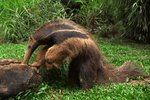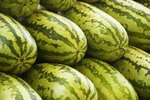
Groundhogs (Marmota monax) are squat, sizable rodents that are found in diverse parts of Canada and the United States, from the province of New Brunswick to Indiana. The diurnal marmots are also frequently referred to as whistle pigs and woodchucks. When it comes to food, groundhogs are predominantly herbivorous creatures, though there are a few exceptions.
Basic Information
These independent mammals live in a broad array of habitat types, including fields, meadows, outer portions of forests and residential yards. They often establish themselves in areas with ample weeds or brush. Groundhogs typically grow to roughly 25 inches in length, and generally weigh around 14 pounds maximum. The boys are approximately 3 percent bigger than the girls in weight. Their fur appears in several color types, including gray, yellowish-brown and deep brown. They have noticeably short limbs, tiny ears and wide heads. Groundhogs generally live between four and five years.
Overall Diet
Some important components of the groundhog diet are foliage from bushes, nuts, grains, ferns, flowers, grass and fruit. Several of the plants the species eats most frequently are chickweed, dandelion, clover, plantains, asters and sorrel. They have a high appreciation for juicy plants. Their fruit favorites include cherries and blackberries. They also readily consume cultivated crops like peas, lettuce, beans, squash, broccoli, corn and soybeans -- and are sometimes considered by humans to be nuisances as a result. Fully mature groundhogs can take in a lot of plant matter -- more than a pound daily.
Not 100 Percent Herbivorous
Although groundhogs for the most part dine only on plants, they occasionally feed on bugs, snails, juvenile birds and eggs. They gravitate toward bigger insects such as June bugs and grasshoppers.
Hibernation
Groundhogs go into hibernation during the winter months each year. In cases when they get out of their burrows before the emergence of plants, they usually make do temporarily by eating tiny branches and tree bark. During the autumn months, groundhogs load up on food -- a means of acquiring fat supplies and staying alive through the winter hibernation period.
Eating Style
When groundhogs look for sustenance, their eating sessions usually last for two hours, maximum. The bulk of their eating behaviors take place in the morning and then again later in the day, in the midst of the afternoon.
References
- Virginia Department of Game and Inland Fisheries: Woodchuck
- Indiana Department of Natural Resources: Woodchuck (Groundhog)
- National Geographic: Groundhog
- University of Michigan Animal Diversity Web: Marmota monax
- IUCN Red List of Threatened Species: Marmota monax
- ESF Adirondack Ecological Center: Woodchuck
- Mass Audubon: Groundhogs
Photo Credits
-
Tom Brakefield/Stockbyte/Getty Images




